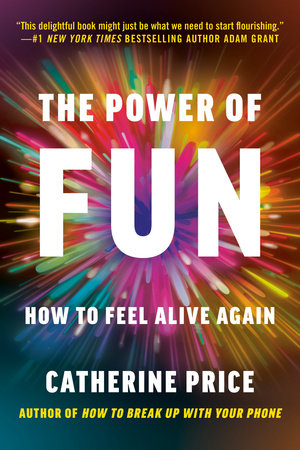The Power of Fun
How to Feel Alive Again
Catherine Price
Paperback
January 2, 2024 | ISBN 9780593241424
AmazonBarnes & NobleBooks A MillionBookshop.orgHudson BooksellersPowell'sTargetWalmart
Hardcover
December 21, 2021 | ISBN 9780593241400
AmazonBarnes & NobleBooks A MillionBookshop.orgHudson BooksellersPowell'sTargetWalmart
Ebook
December 21, 2021 | ISBN 9780593241417
AmazonApple BooksBarnes & NobleBooks A MillionGoogle Play StoreKobo
Audiobook Download
December 21, 2021 | ISBN 9780593452929
About the Book
If you’re not having fun, you’re not fully living. The author of How to Break Up with Your Phone makes the case that, far from being frivolous, fun is actually critical to our well-being—and shows us how to have more of it.
“This delightful book might just be what we need to start flourishing.”—#1 New York Times bestselling author Adam Grant
Journalist and screen/life balance expert Catherine Price argues persuasively that our always-on, tech-addicted lifestyles have led us to obsess over intangible concepts such as happiness while obscuring the fact that real happiness lies in the everyday experience of fun. We often think of fun as indulgent, even immature and selfish. We claim to not have time for it, even as we find hours a day for what Price calls Fake Fun—bingeing on television, doomscrolling the news, or posting photos to social media, all in hopes of filling some of the emptiness we feel inside.
In this follow-up to her hit book, How to Break Up with Your Phone, Price makes the case that True Fun—which she defines as the magical confluence of playfulness, connection, and flow—will give us the fulfillment we so desperately seek. If you use True Fun as your compass, you will be happier and healthier. You will be more productive, less resentful, and less stressed. You will have more energy. You will find community and a sense of purpose. You will stop languishing and start flourishing. And best of all? You’ll enjoy the process.
Weaving together scientific research with personal experience, Price reveals the surprising mental, physical, and cognitive benefits of fun, and offers a practical, personalized plan for how we can achieve better screen/life balance and attract more True Fun into our daily lives—without feeling overwhelmed.
Groundbreaking, eye-opening, and packed with useful advice, The Power of Fun won’t just change the way you think about fun. It will bring you back to life.
“This delightful book might just be what we need to start flourishing.”—#1 New York Times bestselling author Adam Grant
Journalist and screen/life balance expert Catherine Price argues persuasively that our always-on, tech-addicted lifestyles have led us to obsess over intangible concepts such as happiness while obscuring the fact that real happiness lies in the everyday experience of fun. We often think of fun as indulgent, even immature and selfish. We claim to not have time for it, even as we find hours a day for what Price calls Fake Fun—bingeing on television, doomscrolling the news, or posting photos to social media, all in hopes of filling some of the emptiness we feel inside.
In this follow-up to her hit book, How to Break Up with Your Phone, Price makes the case that True Fun—which she defines as the magical confluence of playfulness, connection, and flow—will give us the fulfillment we so desperately seek. If you use True Fun as your compass, you will be happier and healthier. You will be more productive, less resentful, and less stressed. You will have more energy. You will find community and a sense of purpose. You will stop languishing and start flourishing. And best of all? You’ll enjoy the process.
Weaving together scientific research with personal experience, Price reveals the surprising mental, physical, and cognitive benefits of fun, and offers a practical, personalized plan for how we can achieve better screen/life balance and attract more True Fun into our daily lives—without feeling overwhelmed.
Groundbreaking, eye-opening, and packed with useful advice, The Power of Fun won’t just change the way you think about fun. It will bring you back to life.
Read more
Close




